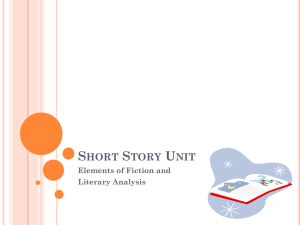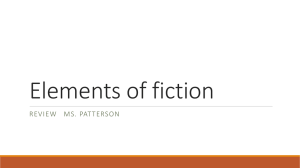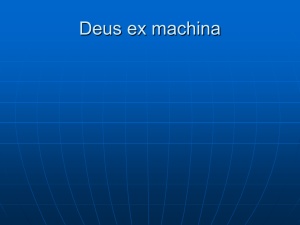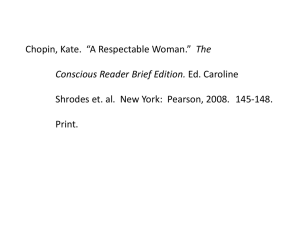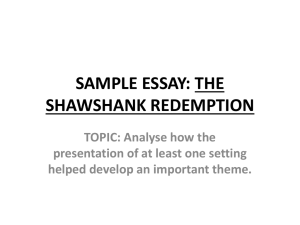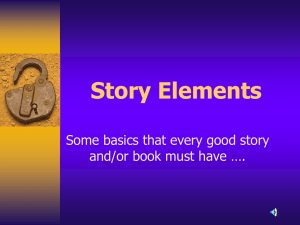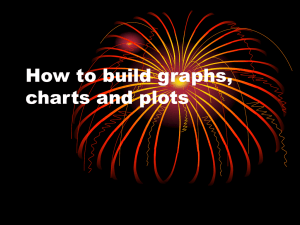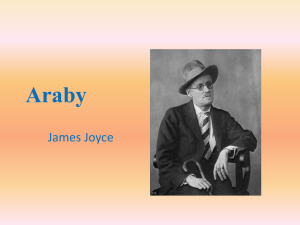Narrative Elements
advertisement
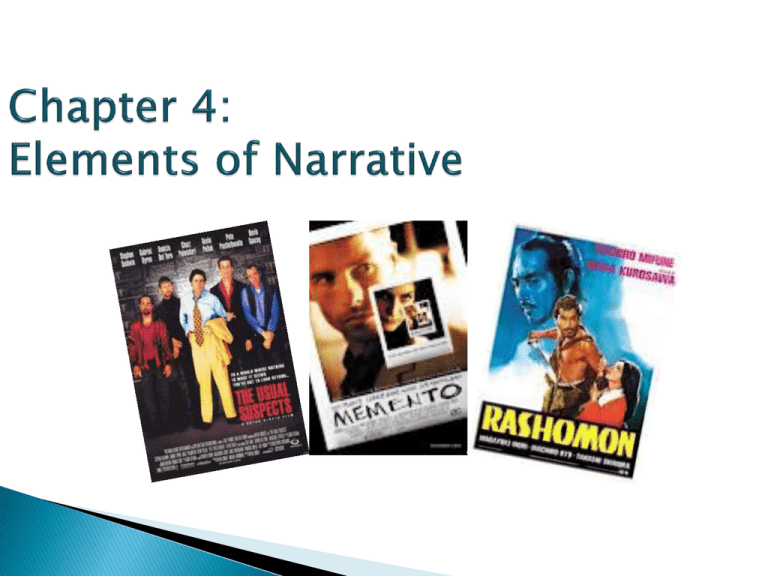
You should be able to differentiate between story and plot differentiate between diegetic and non-diegetic material appreciate the role order plays in narration understand the relationships between screen duration and story duration distinguish between major and minor characters and appreciate their roles in story appreciate the difference between surprise and suspense understand scope as relates to narrative understand the difference between narration and narrator ◦ It is the telling of a story, a structure where the events are arranged in a causeand-effect relationship over time. ◦ “The king died, then the queen died of grief.” ◦ The filmmaker is the guiding hand that determines which aspects of the narrative will be presented, as well as the manner of that presentation Aristotle: three-part structure: Beginning, Middle, End Today: five-part structure ◦ ◦ ◦ ◦ ◦ Exposition (including inciting incident) Rising Action (development) Climax (turning point) Falling Action (transition - winning or losing) Denouement (resolution/conclusion) Jean-Luc Godard: “Yes, to the beginning, middle and end – but not necessarily in that order.” Todorov suggested that conventional narratives are structured in five stages: 1. 2. 3. 4. 5. a state of equilibrium at the outset; a disruption of the equilibrium by some action; a recognition that there has been a disruption; an attempt to repair the disruption; a reinstatement of the equilibrium. This type of narrative structure is very familiar to us and can be applied to many ‘mainstream’ film narratives. The total world of the story-including events, characters, objects, setting, and sound that form the world in which the story occurs is called its diegesis; elements that make up the diegesis are diegetic The things we see and hear that come from outside the world of the story are nondiegetic, such as background music, titles, credits, voice over from omniscient narrator Story (as opposed to Plot) ◦ All narrative elements explicitly presented on screen, PLUS ◦ All the implied events that are not presented directly, but which the audience infers (consider all the time Andy spends in Shawshank that we do not see, but which we can imagine) ◦ All diegetic elements (the world of the story) ◦ Plot is a structure for presenting everything we see and hear in a film ◦ All diegetic material presented in certain order ◦ All nondiegetic material (outside the world of the story, but available to the audience) ◦ (For instance, the music Andy plays for the men is diegetic, while the score music accompanying red’s quest is non-diegetic) ◦ Red’s voice-over in Shawshank is non-diegetic. It is part of the plot of the film. Story Implied events Explicitly presented events Nondiegetic material Plot Plot, for the filmmaker, is the job of selecting events that tell the story. As an example, consider Cameron’s Titanic and how the plot focuses on the story of Rose Calvert’s diamond as a way of setting up and narrowing the scope of the story. Everyone knew the story of the Titanic, so he invented a back story to tell of Rose’s diamond and how she came to possess it. THIS is the plot of Titanic. Consider how Shawshank compresses 20 years of story time-from Andy’s arrival to their reunion in Mexico- into a little over 2 hours of plot time. While story order flows chronologically, plot order can be manipulated. ◦ To emphasize importance or meaning ◦ To establish desired expectations in the audience ◦ To challenge, puzzle and delight the audience Experimental narrative from Christopher Nolan that essentially tells the story backwards, at least in part. The narrative structure disorients the viewer, just as Lenny, the protagonist, is disoriented by his inability to make new memories Citizen Kane begins after Kane’s death, and seeks to piece together the puzzle of his life. The story consists of a series of accounts related in flashback (and flashback within flashback) by those who knew him At the heart of the plot is rosebud, his mysterious final word Quentin Tarantino weaves 3 separate major storylines together into an overlapping tapestry He then re-structures the plot, boldly re-arranging the order of the acts The effect is to leave the viewer disoriented and sometimes confused, but mesmerized! The Usual Suspects begins with a simple premise: A man with a powerful will can bend others to his purpose. But who is this man? Who is Keyser Soze? Every aspect of the story- told out of sequence- serves this central mystery. The film’s ultimate resolution not only resolves the story, but fulfills the central premise. Trainspotting follows the life of Renton and his relationship to both his friends and his drugs. It employs an episodic, picaresque narrative structure, but also a more traditional narrative structure In any plot, events have a logical order, and a logical hierarchy. Some are more important than others, and we infer their significance through the selection and arrangement of details of action, character, and setting. Even events that seem relatively minor can be significant. We need to accept that every event included in the narrative is there for a reason. This minor event reveals the callous nature of the men, implying that incarceration is dehumanizing; later, we will see them evolve, under Andy’s influence It shows the cruelty and indifference of the guards (particularly Handley, an important minor character) It establishes the strength of Andy by contrasting his strength and silence to Fat Ass’s weakness Establishes a connection between Andy and Red, who is forced to re-consider the man he has bet on; this also sets up their friendship. Finally, when Andy asks. “What was his name?” it sets up Andy’s basic humanity, a thread developed throughout the film. Events take time to occur. In most mainstream films, plot duration and story duration are stable, that is, the same. Story Duration: the amount of time the implied story takes to occur (Shawshank: 20 years) Plot Duration: the elapsed time of the explicitly Screen Duration: the movie’s running time onscreen (Shawshank: 2:22 minutes) presented events – the elapsed time of the plot. (Shawshank: 20 years) Plot Duration: Approximately 1 Week (Thompson’s Research) Story Duration: 70 Years (Kane’s life) Screen Duration: 1 hour 59 minutes Story duration = 1 week Plot duration: 3 days out of that week Day 1 Day 4 Screen duration: 90 minutes Day 7 Summary Relationship: screen duration is shorter than plot duration (most common) Example: Kane’s first marriage Stretch Relationship: screen duration is longer than plot duration (second most common) Example: Odessa Steps scene of Battleship Potemkin http://www.youtube.com/watch?v=VTyOC8GF-qg http://www.youtube.com/watch?v=Ps-v-kZzfec Real Time: screen duration corresponds directly to plot duration (least common) Example: High Noon (1952) and Rope (1948) Surprise: the audience is taken unawares. Suspense: the audience experiences anxiety brought on by partial uncertainty. Two men sit at a table. Unbeknownst to them, there is a bomb under the table, set to go off at 1 o’clock. We were shown the bomb before the men sat down. There is a clock in the decor. It shows 15 minutes to one. The men....talk, as the clock keeps the time. The audience, meanwhile, is in agony! (Hitchcock to Truffaut) An incident that occurs once is accepted as just part of the plot. Repetition, however, suggests a pattern and a higher level of importance. It encourages us to pay attention. It can signal that a particular event has meaning or significance that should be acknowledged. Can be done in several ways ◦ A character may remember something several times ◦ Flashbacks ◦ Slow-motion sequences (mythical quality) defined as any image, audio or visual, that a director periodically repeats in a movie to help stabilize its narrative. By its repetition, the image calls attention to itself. Allows for some variation of pattern, but should retain the integrity of the original image. Shawshank uses this motif a few times: Red has 3 hearings, followed by 3 “stamps” the last of which varies the pattern Red’s journey echoes Brooks’, and consciously acknowledges it (so was Red) We see an alternative version of Andy’s planning of his escape, this time with the full story revealed Another critical aspect of narrative is scope, that is the limitation placed upon the range, in time and place, of the story. Stories can range from the distant past to the narrative present, or they can be narrowly focussed on a short period of time, even a matter of moments. They can take us from galaxy to another, or they can remain inside a single room. They can present a narrow perspective on their world, or they can show us the world from a number of perspectives. Tree of Life took us back to the dawn of time Shawshank showed us 20 years in prison Cloud Atlas took us across place and time Chaplin showed us 60 years in Charlie’s life The Girl focused on the just the making of The Birds The Truman Show gave us 30 years in Truman’s life Saving Private Ryan focused on the larger narrative of the Band of Brothers episodically sought to capture the Normandy Invasion, and the smaller story of the attempts to save Ryan. American experience in Europe from before the Normandy invasion to the last days of the European theatre We instinctively understand that the camera is a visual recorder – a visual narrator. It can be omniscient or restricted (limited) in that it reveal information to us only when a character discovers it (Chinatown) It can be limited to a physical point of view (what a character may see) or it can be subjective to the point if revealing mental processes such as dreams, fantasies, etc. Films may also have auditory narrators: First-person narration from character in the film (Shawshank or Terence Malick’s Badlands ) Voice-over narration from a detached voice who is not a character in the film (Lemony Snicket) Direct-address narration occurs when a character breaks the fourth wall that separates us from the film (Fight Club) Round characters vs. flat characters Frodo and Indi – flat or round characters? Don’t think of the term “flat character” as necessarily critical or derogatory. Protagonist vs. Hero ◦ While some protagonists have virtuous qualities, others may have a darker, more hostile nature. Antagonist: Opposes the protagonist Can be an individual or part of a larger group Or a force of nature Motivation ◦ All characters need motivation in order to be believable, but occasionally some characters – often the antagonist – have eccentric actions for which we can identify no motivation… … and with whom we (hopefully) do not have any familiarity.
